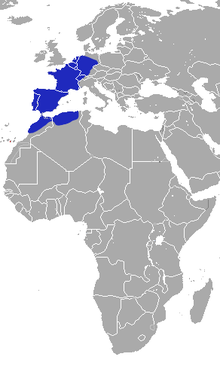Crocidura russula
| Greater white-toothed shrew | |
|---|---|
 |
|
| Scientific classification | |
| Kingdom: | Animalia |
| Phylum: | Chordata |
| Class: | Mammalia |
| Order: | Eulipotyphla |
| Family: | Soricidae |
| Genus: | Crocidura |
| Species: | C. russula |
| Binomial name | |
|
Crocidura russula (Hermann, 1780) |
|
 |
|
The greater white-toothed shrew (Crocidura russula) is a small insectivorous mammal found in Europe and North Africa. It is the most common of the white-toothed shrews. This species is found along the Mediterranean, Netherlands, Belgium, Germany and Portugal; in addition, the Osorio shrew of the Canary island of Gran Canaria, originally described as a separate species (Crocidura osorio), was later discovered to be a population of introduced greater white-toothed shrew. Its preferred habitats are grassland and woodland. It is slightly larger than the lesser white-toothed shrew but otherwise very similar, and can often be distinguished only by close inspection of its teeth which are unpigmented.
The greater white-toothed shrew is distinguished by a careful examination of their unpigmented teeth. Like other "white tootheed-shrews", C. russula lacks the deposition of iron in their enamel at the tips of their teeth This particular species has a greyish or reddish brown upper coat with a yellowish grey coat in the underside The greater white-toothed shrews are part of the medium-sized shrews and weigh around 11 grams to 14 grams The head and body length of C. russula is about 6 to 9 cm and the tail length averages to about 3 to 4.3 cm
C. russula are fond of temperate regions with plentiful insects. They are generally found in habitats such as grasslands, woodlands, hedgegrows and prime agricultural areas. To prepare for colder seasons, these shrews can be found living near farms and gardens. The greater white-toothed shrews tend to build their nest under stones, logs, and in abandoned burrows. Typically these shrews are found in elevations below 1000 meters
The greater white toothed shrew feeds mainly on invertebrates and occasionally small rodents, lizards and small amphibians.
...
Wikipedia

